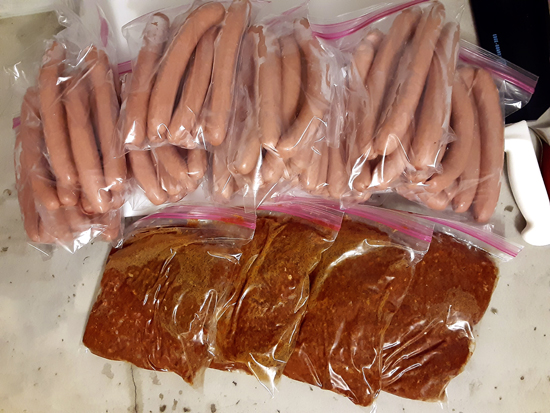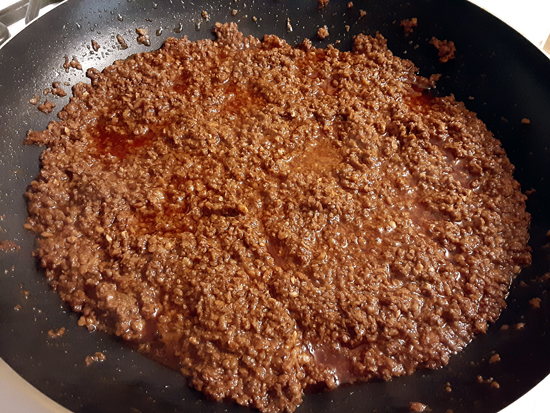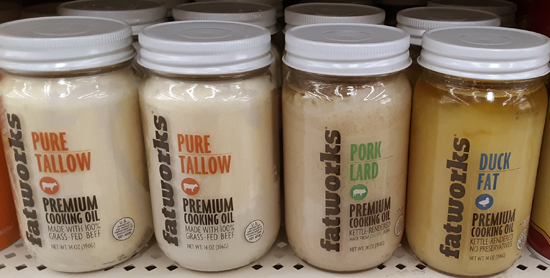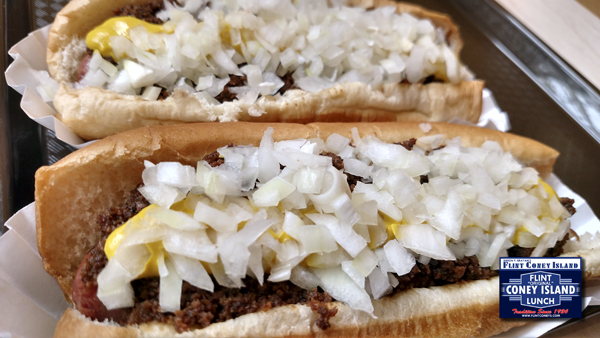
A pair of Flint-Style Coneys at the former Palace Coney Island at the Genesee Valley Shopping Center in Flint, using their own recipe with Abbott’s ground beef heart sauce base, Koegel Coney Franks, and Coney buns from Mr. Bread. The restaurant closed in June of 2020.
Related:
Abbott’s Original Coney Island Topping & Koegel Coney Franks

Purchased at Abbott’s Meat in Flint on March 18, 2016, a 10-lb box of Koegel Coney Franks, and a 10-lb bag of raw complete Flint Coney sauce.
Both of these items are available at the Abbott’s Meat plant on Blackington northwest of Corunna and Ballenger. The plant has no retail shop … But you’re welcome to walk in the door, go to the receptionist’s window, and ask for what you’d like. It’ll be brought out to you.
Abbott’s Original Coney Island Topping is also available for home purchase from Lynch Shipping, in partnership with Koegel Meats, in a 4 lb bag at buykoegels.com. A 10 lb bag is also available on their site by clicking here.
Koegel Viennas are also available for home purchase from Lynch Shipping, in partnership with Koegel Meats, in a 10 lb box at buykoegels.com. The Coney Franks are currently unavailable online.
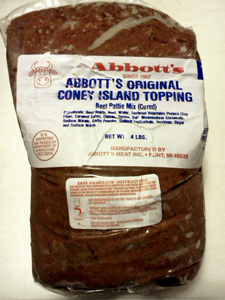
If you know someone from Michigan and you offer them a chili dog somewhere, you might hear a response similar to “Well it’s not a coney, but alright.” If you’re the person from Michigan in that conversation, you’ll know there’s nothing that can replace the coney you know and love. It has to have the “snap” of the natural lamb or sheep casing on a properly-grilled German “coney dog”, which is a variation of the European-style Frankfurter Würstel or Vienna sausage. The coney has to be topped with a flavorful meat topping having the memorable flavor of ground beef heart and maybe ground beef along with some other organ meats (depending on your style and/or restaurant of choice), cumin, and paprika. And purists always have that meat topping garnished with a couple lines of good yellow mustard, and onions minced to be silky smooth.
If you’re the kind of person who gets deeper into this sort of thing, you’ll know there are three basic coney varieties: The dry-sauced Jackson Coney, developed by George Todoroff in about 1914; The juicier-sauced Detroit Coney, developed by someone at either of the side-by-side American or Lafayette Coney Islands (there are too many versions of the story to sort out) in about 1917; And of course the Flint Coney, with the Flint Coney Island restaurant opening south of the Flint River at 202 S. Saginaw St. in 1926 (the year it first showed up in R.L. Polk & Co.’s Flint City Directory).
There is serious debate about which one of these is “best”. Even between the two Detroit Coney shops that sit next to each other and are owned and operated by cousins in the Keros family, there are “turf wars”. Honestly, you’ll like what you grew up with, and what you like will always be “best” for you. It really is that simple. None are “best”, they’re all good, and they all have their followers. and detractors. That will never change.
In early January 2021 after a comment claimed Lafeyette Coney Island had stopped using beef heart in the 1960s, I emailed the store and asked. The answer was that they do not use beef heart there. As I know they still use beef heart in the sauce next door at American Coney Island, sauce made by Detroit Chili Co., Inc., the differences in the two sauces is clear.
There is also regular discussion about which of these three evolved into the other two. The Jackson and Detroit Coney shops actually had no bearing on the development of the Flint Coney. Likewise, the originators of all three Coneys likely had no clue what the others were doing until long after the fact.
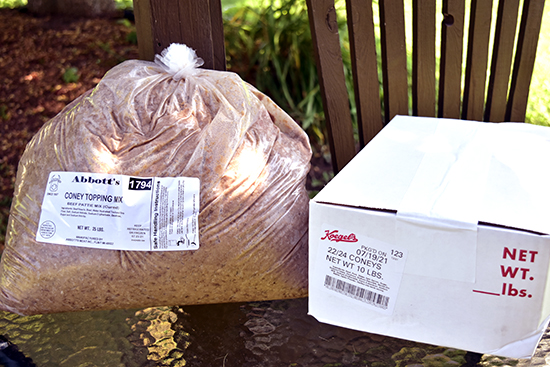
One thing I’m doing my best to correct, is peoples’ perception of what a Flint Coney really is. So before we go any further, let’s get something straight:
There is no such thing as a single restaurant recipe for Flint Coney sauce.
Many people will insist that the a “Flint Coney sauce” recipe made with ground beef, ground hot dogs, and tomato paste is “the original Recipe” and “my [fill in the blank] relative got the recipe from the owner/the owner’s wife/an employee/it was published in the Journal after the owner’s death”. Even if I tell people the retaurants begin with a 25lb bag of raw ground beef hearts from Abbott’s Meat, they tell me I’m wrong.
A couple of notes about the 25lb restaurant base product: It’s provided unfrozen, which you can see from the label where it reads “Keep Refigerated”. Because it’s not frozen, this product is also unavailable through BuyKoegels.com. However, you can buy it at Abbott’s Meat and spice it your own way. As it’s not frozen, dividing this large amount into quart freezer bags, freezing it, and then using only what you need is certainly possible. It’s also rather inexpensive, that morning going for about $44, or about $1.75/lb.
We can now compare the labels to see how Abbott’s creates a “finished” Flint coney sauce.

Abbott’s Coney Topping Mix; Beef Pattie Mix (Cured), 25 lbs – Ingredients: Beef Hearts, Beef, Water Hydrated Textured Soy Flour, Salt, Sodium Nitrate, Sodium Erythorbate, Dextrose, Sugar and Sodium Nitrite
Abbott’s Ready To Cook Coney Island Topping; Beef Pattie Mix (Cured), 4 or 10 lbs – Ingredients: Beef Hearts, Beef, Water Hydrated Textured Soy Flour, Onions, Spices, Salt, Monosodium Glutamate, Sodium Nitrate, Garlic Powder, Sodium Erythorbate, Dextrose, Sugar and Sodium Nitrite
These are both raw products, so make sure to cook them thoroughly.
The completed “ready to cook” product adds Onions, Spices, Monosodium Glutamate and Garlic Powder to the same Coney Topping Mix that the restaurants start with. When I make Flint Coney sauce using beef hearts I’ve ground myself, for the onions I use a white onion (not sweet) and mince them rather fine. This is the same minced onion I top the sauce with when serving them. Also, my three spices to add for that “Spices” ingredient are Mild Chili Powder, Smoked Paprika and Cumin, in equal amounts. The MSG isn’t needed for home use, just spice the cooked sauce to taste. In adding the Onion, Garlic Powder, and Spices, you simply want to do your best to match the flavor of the sauce from your favorite restaurant. There’s no real recipe here, every restaurant or chain prepares theirs differently.

The Abbott’s Coney Sauce described below and shown in these photos, available in 4# and 10# bags, is a very recent development, and most restaurants don’t use it.
Some restaurants that serve the Flint Coney are decidedly more popular than others. Certain Flint Coney restaurants might also have a group of local followers, or might be on an interstate or tourist travel route with visitors from out-of-town viewing it as a “destination”. Ask anyone who’s been through town, grown up there recently, or seen recent news reports where to get a real Flint Coney and they’ll likely mention Starlite or Angelo’s.
Many people are also insistent that the restaurants serve the Koegel Vienna. The reality though is that they serve the Koegel’s Coney Frank, which is a variation of the Vienna. From Koegel’s own web site:
Coneys … Description: This is a blend of pork, beef and our unique spices stuffed into a natural casing and then smoked using natural hardwoods. We change the ingredients just a little from our Viennas so that the product can be held on a grill for an extended period of time … Ingredients: Beef, Pork, Water, Salt, Spices, Sugar, Sodium Citrate, Dextrose, Sodium Diacetate, Nonfat Dry Milk, Sodium Eryhtorbate, Spice Extractives, Sodium Nitrite, Garlic, stuffed into lamb casing.
Simion Brayan was working on the Flint Coney in the early 1920s when he went to Albert Koegel for the sausage itself. The issue was that Brayan needed a hot dog that would last longer on a flattop grill throughout restaurant service. According to “Coney Detroit”, by Katherine Yung and Joe Grimm, to create the Coney Koegel’s removed the nonfat dry milk and sugars from the Vienna. In addition, “Two to Go: A Short History of Flint’s Coney Island Restaurants” from the Genesee County Historical Society also indicates they changed the proportion of ingredients so they contained more fat pork than beef, while making the Coney somewhat slimmer. There was no indicated change in the casing as they both use lamb.
What’s important is that no matter what changes cooks make in cooking their own sauce from scratch using the 25# bag of Abbott’s Meat’s sauce base, or whether or not they want to call themselves “original”, the sauce and Koegel’s Coney are the two basic components that have always defined the Flint Coney. Anything that’s termed a “Flint-style Coney” can always be traced back to those two truly original items.
After buying the franks and sauce, I first thaw them down before repackaging. I then repack the franks into quart freezer bags, eight franks to a bag. As the 10lb box is sold by weight, there are approximately 90 – 92 franks in each box, although that number will be higher or lower depending on the packer. That last bag will likely have a count other than eight franks. The sauce then also goes into quart freezer bags, 1lb per back. I then remove as much air as possible during closing before refreezing the bags.
Does thawing then refreezing cause differences in these products before a final thaw prior to use? There are likely some flavor and textural changes, but they’re honestly not noticable. As these products have been sold frozen for some time now, the thaw/freeze cycle is common usage among home cooks. I’ve not yet heard of any complaints about it.
The Abbott’s prepared sauce does need a bit of fat when cooking. I generally use a couple tablespoons lard for each lb of sauce, although a good white shortening would also be acceptable.
References mention earlier restaurants using tallow, the beef equivalent of lard, which makes sense as the sauce is made of beef. But tallow is more expensive than lard or shortening, and the latter two don’t change the flavor of the sauce too much anyway. Cook the sauce to at least a temperature of 160°F and then continue a slow simmer until it’s rendered to your desired constistency.

